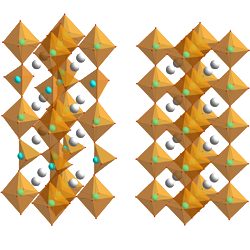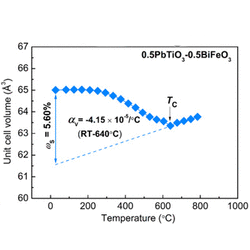Charge, spin and orbital are three degrees of freedom of electron. Up to now, many different electronic devices have already been developed on the basis of the charge or spin property only. However, it is a big challenge on how to couple the charge and spin properties together and realize the mutual control in a single-phase material. By means of the various physical effects of quantum functional materials, one can design a wide variety of electronic devices with special functions. Therefore, how to discover new quantum functional materials with novel quantum effects is extremely important. Because the amount of solid state materials that can be formed under ambient pressure is limited, the extraordinary preparation as represented by high pressure and high temperature has been becoming an effective method to explore new quantum functional materials. Our research group will break through the limitations of ambient-pressure synthesis conditions, find new magnetoelectric quantum functional materials at extended pressure and temperature conditions, tailor their coefficient of thermal expansion (CTE), and study the structure and comprehensive physical properties, reveal the structure-property relationships, and finally provide a crucial material foundation for the application-oriented ME multifunctional devices with controllable thermal expansion.
Detailed research interests
1. High-pressure synthesis and physical properties of novel magnetoelectric functional materials.
In this direction, we will use the irreplaceable advantages of high-pressure and high-temperature extreme conditions to prepare new magnetoelectric functional materials that cannot be formed under ambient conditions, including magnetoelectric multiferroic materials, high-temperature ferro/ferrimagnetic half metals, and high Curie temperature semiconductors, etc.
Representative works:
B. W. Zhou
et al.,
Physical Review Letters 130, 146101 (2023)
more
Z. H. Liu
et al.,
Advanced Materials 34, 2200626 (2022)
more
G. X. Liu
et al.,
Nature Communications 13, 2373 (2022)
more
X. B. Ye
et al.,
Nature Communications 12, 1917 (2021)
more
L. Zhou
et al.,
Advanced Materials 29, 1703435 (2017)
more
X. Wang
et al.,
Physical Review Letters 115, 087601 (2015)
more
Y. W. Long
et al.,
Nature 458, 60 (2009)
more
2. High-pressure growth and intrinsic physics of large-size magnetoelectric single crystals.
Single crystal is the best system to investigate intrinsic physical properties. However, it is a big challenge in the worldwide on how to grow large-size single crystal under high pressure. This direction breaks through the technical bottleneck and develops advanced large-volume high-pressure single crystal growth methods, prepares new magnetoelectric single crystals and studies the underlying physics.
Representative works:
S. J. Qin
et al.,
Chinese Physics B 31, 097503 (2022)
more
S. J. Qin
et al.,
Inorganic Chemistry 60, 6298 (2021)
more
Y. X. Liu
et al.,
Physical Review B 101, 144421 (2020)
more
Y. W. Long
et al.,
Journal of Physics: Condensed Matter 23, 245601 (2011)
more
3. Multiple manipulations of exotic quantum states.
High pressure is not only an important material preparation method, but also a useful manipulation method for quantum states, since in-situ high pressure can significantly reduce the interatomic distance, enhance the orbital hybridization, and expand the bandwidth. In this direction, we will study the exotic magnetoelectric quantum states induced by high pressure and other combined stimuli such as temperature, magnetic field, electric field and light field etc.
Representative works:
Z. H. Liu
et al.,
Journal of the American Chemical Society 142, 5731 (2020)
more
J. Y. Yang
et al.,
Physical Review B 92, 195147 (2015)
more
J. Y. Yang
et al.,
Inorganic Chemistry 54, 6433-6438 (2015)
more
Y. W. Long
et al.,
Chemistry of Materials 24, 2235 (2012)
more
4. Structure and composition design, thermal-expansion control, and related mechanism of novel magnetoelectric functional materials.
Thermal expansion is a longstanding issue for the application of functional materials and devices. The discovery of negative thermal expansion (NTE) materials makes it possible to tailor the overall coefficient of thermal expansion (CTE) of functional materials and devices. In this topic, by taking advantages of our high-temperature and high-pressure apparatus, we focus on the exploring of novel magnetoelectric functional materials with controllable thermal expansion, and related physical mechanism, according to the current research status of functional NTE materials.
Representative works:
H. T. Zhao
et al.,
Small 20, 2305219 (2024)
more
Z. Pan
et al.,
ACS Applied Materials & Interfaces 14, 23610 (2022)
more
Z. Pan
et al.,
Chemistry of Materials 31, 6187 (2019)
more
Z. Pan
et al.,
Journal of the American Chemical Society 139, 14865 (2017)
more
5. Neutron and X-ray study of magnetic materials.
Neutron and X-ray scatterings are two of the state-of-the-art techniques for the studies of microscopic physical properties in magnetic materials. Making use of large scientific facilities such as neutron sources and synchrotron light sources, they can provide valuable information regarding the multiple degrees of freedom for the correlated electrons in condensed matters. In this regard, we use a variety of neutron and X-ray techniques to investigate the magnetic ordering, orbital contributions, and various elementary excitations of magnetic systems. By doing so, we are able to establish the magnetic Hamiltonian of the systems and explore the microscopic mechanisms of their exotic physical properties.
Representative works:
Y. Shen
et al.,
Nature 540, 534 (2016)
more
Y. Shen
et al.,
Physical Review X 13, 011021 (2023)
more
Y. Shen
et al.,
Physical Review Letters 129, 207201 (2022)
more
Y. Shen
et al.,
Nature Communications 10, 4530 (2019)
more



 In this direction, we will use the irreplaceable advantages of high-pressure and high-temperature extreme conditions to prepare new magnetoelectric functional materials that cannot be formed under ambient conditions, including magnetoelectric multiferroic materials, high-temperature ferro/ferrimagnetic half metals, and high Curie temperature semiconductors, etc.
In this direction, we will use the irreplaceable advantages of high-pressure and high-temperature extreme conditions to prepare new magnetoelectric functional materials that cannot be formed under ambient conditions, including magnetoelectric multiferroic materials, high-temperature ferro/ferrimagnetic half metals, and high Curie temperature semiconductors, etc.














O3.png)



